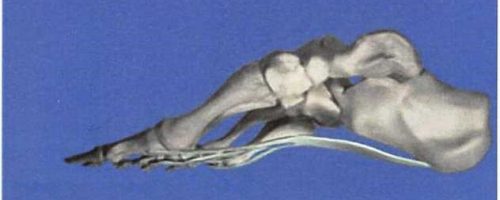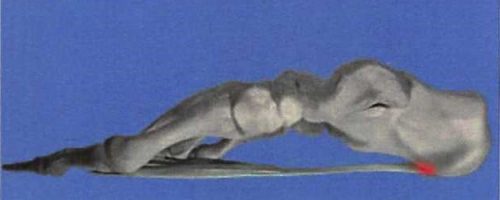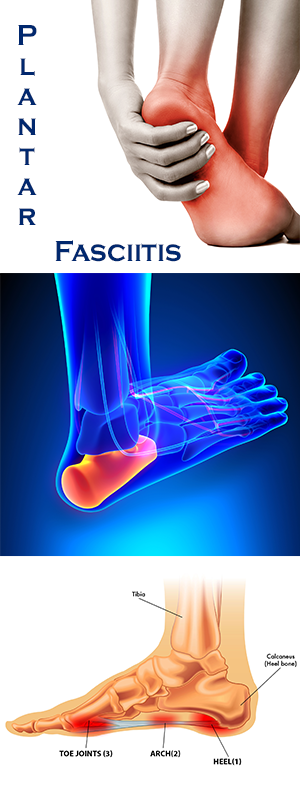What’s a Plantar Fasciitis?
Plantar Fasciitis is the most common cause of heel and foot pain. The suffix “itis” means “inflammation”.


When you are sitting, your foot length and arch height are optimal. And your plantar ligament is at rest!
When you stand, your foot gets longer as your arch drops down. Much too much if you do overpronate. Then your plantar ligament will get overextended and overloaded. Micro-tears may occur anywhere into the fascia, from heel to toes. But damages most are most often located nearby the ligament connection with the bottom of the heel – see red area.
How do I Know if I Have a Plantar Fasciitis?
You are most likely suffering from this condition if:
1. your stiffness or pain area is located at the bottom aspect of your heel bone or right under your arch;
2. you feel more pain at first steps in the morning or at first steps after long periods of sitting;
3. you can elicit pain upon self-palpation of your most sensitive area;
4. you feel unusual foot and leg fatigue and pain by the end of the day or after physical activities.
Can a Heel Spur seen on X-Rays be the Source of my Heel Pain?
First: there are no nerves within your heel bones.
Second: your heel spur is only a normal bone response to an abnormal ligament pull. As you overpronate, your plantar ligament pulls excessively at its insertion on your heel bone. Bone always responds to increased demand. In your case, your heel bone did build up more bone toward fascia traction just to reduce the excess pull.
Third: Your heel pain comes from your nerves running around and within your damaged, micro-teared, inflamed and much fragilized plantar ligament. Torn ligament fibers are surrounded by scar tissue lowering the normal elasticity of your plantar fascia. As you put your foot on the ground, your rigid ligament is instantly overloaded and aches more and more! And all your nerves endings stand on guard!

How Did I Get that Limiting Condition?
| Root Cause and aggravating factors that progressively overload and damage your plantar ligament are:
|
What is a Plantar Fascia?
It’s a band of elastic fibrous tissue connecting your foot bones altogether. Your plantar fascia is located at the bottom of your foot, from heel to toe joints. It’s the longest ligament of your body. But not the strongest!
Know the Functions of your Plantar Ligament?
Your plantar ligament supports, aligns, balances and protects your whole body in two ways:
1. It only allows the necessary amount of foot pronation to occur to provide you with an effective shock absorption system, from heel up to spine;
2. It stops foot pronation soon enough to maintain your skeletal alignment from heels up to spine.
What’s Pronation?
A normal amount of cholesterol is good for your body! A normal of foot pronation is crucial! Here’s why. Pronation describe the normal capacity of your foot to change its shape to adapt to natural ground irregularities and to capture most of the shock to cushion the rest of your body. Normal foot pronation occurs in 3D as your arch height will drop down 5 mm, as your heel bone will roll in 5° from the vertical and as your pinky toe will shift 5 mm toward the outside.

Areas of plantar fasciitis may occur anywhere along your plantar ligament. Partial tears, inflammation and pain may be located right under your heel(1), under your arch(2) or under your toe joints(3).
Know the Best Ways to Fix Your Ailing Feet?
Custom-made Foot Orthotics are designed to support your feet and keep your whole body in correct alignment. Preventing overpronation and excessive foot flattening by wearing orthotics to support optimal arch height is:
· the first-line treatment for a plantar fasciitis
· the most reliable long-term cure.
A restored arch height significantly reduces the daily pull on the plantar ligament by relaxing the ‘bowstring” function of the fascia. Full-time wear of custom-made orthotics fitted into prescription shoes – albeit orthopedic or stylish shoes– will address both your symptoms and the cause of your overpronation & plantar fasciitis.
Shock Wave Therapy If your heel pain began more than 3 months ago, your plantar ligament is full of scar tissue in need to be removed. A low impact shock wave is then delivered right into your damaged and pain areas to:
1. promote optimal healing – by removing scar tissue in a way to help restoring original ligament strength & flexibility;
2. knock off your heel pain real fast.
Right after your first treatment, your pain shall be mostly gone! But you will need 3 consecutive weekly sessions to get optimal and sustained results. And you will have to wear your prescription orthotics and shoes to avoid recurrence!
Protective Anti-Stress Foot Taping
Your foot will be taped right after your first and second shock wave treatments. This high-resistant taping treatment acts as a second plantar ligament taped right on top of your skin. This second skin will protect your weakened ligament for the next 3 to 5 days. It is critical to keep away any recurrent overloading stretch on your damaged fascia. Foot taping, either combined with shock wave and with cortisone injection, will impact your results.
Plantar Fascia Compression Sleeve
As part # 4 of your long-standing plantar fasciitis treatment plan, you will be fitted with plantar fasciitis compression sleeves to assist your weakened ligament for 3 to 4 weeks after you are done with your shock wave and taping treatment program.
Leg Muscles Stretching
Increasing the flexibility of your calf & hamstring muscles may be part of your treatment. As time goes by, tightness in these muscle groups increases foot pronation substantially. It means that, as your arches flatten, and your feet elongate, the excess pull caused by your short & stiff leg muscles will damage your plantar ligaments. As part # 5 of your long-standing plantar fasciitis treatment plan, we will show you how, how often and when to stretch. Wear prescription shoes having 1’’1/4 to 2” heels. Stay away from flats and avoid walking barefoot or in socks at home!
When you are sitting, your foot length and arch height are optimal. And your plantar ligament is at rest!
Cortisone Injection – as a Last Resort Option
Only reserved to 0,5% of our patients as a last resort option after showing full compliance with above five conservative treatment options.
We perform comfortable cortisone micro-injections!
Why? First, we absolutely want you to have a positive to memorable experience. Second, this is the only way to inject the cortisone everywhere you need it. It means multiple micro-injections all around the painful areas.
How? We freeze your heel first with local anesthetics. We wait 10 minutes. We test your heel for total numbness. Not sure when we test? We add some more freezing. Wait and test again. Till your heel is completely numb.
Then, all your pain area will be thoroughly injected with all the cortisone you need. Effectively, with certainty, without rush, often without pain. We never inject inside your heel bone as no nerves are running inside your bones.
Instead, we inject all around and into your inflamed plantar ligament and nerve endings. For additional precision in most difficult cases, cortisone injections must be performed under ultrasonic guidance – in our Gatineau clinics only!
Your Home Pain Control
Icing 20 minutes every 60 minutes using cold packs is the classic most natural and effective way to control pain and inflammation. Know the best way to ice?
Fill a Styrofoam cup with water, store it into your freezer till you get a solid insulated block of ice. Peel some Styrofoam away to apply ice onto the pain area for 7 minutes every 60 minutes. Always keep your iceberg moving not to freeze your skin!
A pain control cream may be prescribed and dispensed to you. You will get a one-on-one demonstration as how, where and when to apply your cream the most effective way.
Oral pain medications. We do not like to prescribe drugs. We found that most are not effective for long-standing heel pain. Because none of them will address the root cause of your problem. Because you run the risk to get more side-effects than desired effects. Plus, oral anti-inflammatory medications – such as Advil – have been shown to delay healing. This is why these drugs are not recommended in combination with shock wave therapy. If need be, use over-the-counter Tylenol tablets to help you get some temporary pain relief before your initial visit.

